Guy Carrault
Multiscale Low-Frequency Memory Network for Improved Feature Extraction in Convolutional Neural Networks
Mar 13, 2024



Abstract:Deep learning and Convolutional Neural Networks (CNNs) have driven major transformations in diverse research areas. However, their limitations in handling low-frequency information present obstacles in certain tasks like interpreting global structures or managing smooth transition images. Despite the promising performance of transformer structures in numerous tasks, their intricate optimization complexities highlight the persistent need for refined CNN enhancements using limited resources. Responding to these complexities, we introduce a novel framework, the Multiscale Low-Frequency Memory (MLFM) Network, with the goal to harness the full potential of CNNs while keeping their complexity unchanged. The MLFM efficiently preserves low-frequency information, enhancing performance in targeted computer vision tasks. Central to our MLFM is the Low-Frequency Memory Unit (LFMU), which stores various low-frequency data and forms a parallel channel to the core network. A key advantage of MLFM is its seamless compatibility with various prevalent networks, requiring no alterations to their original core structure. Testing on ImageNet demonstrated substantial accuracy improvements in multiple 2D CNNs, including ResNet, MobileNet, EfficientNet, and ConvNeXt. Furthermore, we showcase MLFM's versatility beyond traditional image classification by successfully integrating it into image-to-image translation tasks, specifically in semantic segmentation networks like FCN and U-Net. In conclusion, our work signifies a pivotal stride in the journey of optimizing the efficacy and efficiency of CNNs with limited resources. This research builds upon the existing CNN foundations and paves the way for future advancements in computer vision. Our codes are available at https://github.com/AlphaWuSeu/ MLFM.
Heart Rate Variability and Respiration Signal as Diagnostic Tools for Late Onset Sepsis in Neonatal Intensive Care Units
May 12, 2016



Abstract:Apnea-bradycardia is one of the major clinical early indicators of late-onset sepsis occurring in approximately 7% to 10% of all neonates and in more than 25% of very low birth weight infants in NICU. The objective of this paper was to determine if HRV, respiration and their relationships help to diagnose infection in premature infants via non-invasive ways in NICU. Therefore, we implement Mono-Channel (MC) and Bi-Channel (BC) Analysis in two groups: sepsis (S) vs. non-sepsis (NS). Firstly, we studied RR series not only by linear methods: time domain and frequency domain, but also by non-linear methods: chaos theory and information theory. The results show that alpha Slow, alpha Fast and Sample Entropy are significant parameters to distinguish S from NS. Secondly, the question about the functional coupling of HRV and nasal respiration is addressed. Local linear correlation coefficient r2t,f has been explored, while non-linear regression coefficient h2 was calculated in two directions. It is obvious that r2t,f within the third frequency band (0.2<f<0.4 Hz) and h2 in two directions were complementary approaches to diagnose sepsis. Thirdly, feasibility study is carried out on the candidate parameters selected from MC and BC respectively. We discovered that the proposed test based on optimal fusion of 6 features shows good performance with the largest AUC and a reduced probability of false alarm (PFA).
 Add to Chrome
Add to Chrome Add to Firefox
Add to Firefox Add to Edge
Add to Edge